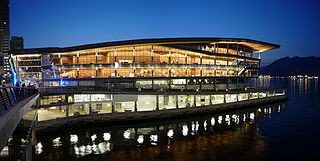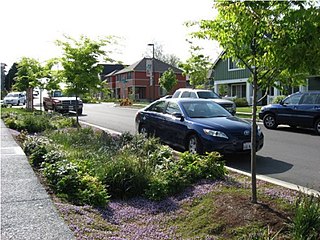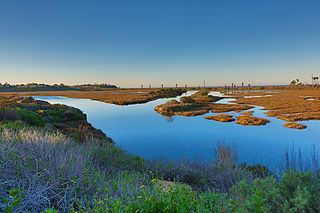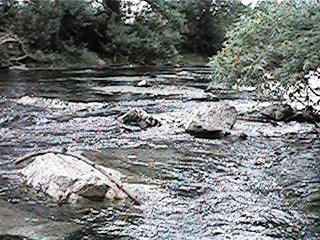
The Santa Ana River is the largest river entirely within Southern California in the United States. It rises in the San Bernardino Mountains and flows for most of its length through San Bernardino and Riverside counties, before cutting through the northern Santa Ana Mountains via Santa Ana Canyon and flowing southwest through urban Orange County to drain into the Pacific Ocean. The Santa Ana River is 96 miles (154 km) long, and its drainage basin is 2,650 square miles (6,900 km2) in size.

The San Francisco Public Utilities Commission (SFPUC) is a public agency of the City and County of San Francisco that provides water, wastewater, and electric power services to the city and an additional 1.9 million customers within three San Francisco Bay Area counties.

Water reclamation is the process of converting municipal wastewater (sewage) or industrial wastewater into water that can be reused for a variety of purposes. Types of reuse include: urban reuse, agricultural reuse (irrigation), environmental reuse, industrial reuse, planned potable reuse, and de facto wastewater reuse. For example, reuse may include irrigation of gardens and agricultural fields or replenishing surface water and groundwater. Reused water may also be directed toward fulfilling certain needs in residences, businesses, and industry, and could even be treated to reach drinking water standards. The injection of reclaimed water into the water supply distribution system is known as direct potable reuse. However, drinking reclaimed water is not a typical practice. Treated municipal wastewater reuse for irrigation is a long-established practice, especially in arid countries. Reusing wastewater as part of sustainable water management allows water to remain as an alternative water source for human activities. This can reduce scarcity and alleviate pressures on groundwater and other natural water bodies.

The Metropolitan Water District of Southern California is a regional wholesaler and the largest supplier of treated water in the United States. The name is usually shortened to "Met," "Metropolitan," or "MWD." It is a cooperative of fourteen cities, eleven municipal water districts, and one county water authority, that provides water to 19 million people in a 5,200-square-mile (13,000 km2) service area. It was created by an act of the California State Legislature in 1928, primarily to build and operate the Colorado River Aqueduct. Metropolitan became the first contractor to the State Water Project in 1960.

The Vancouver Convention Centre is a convention centre in Vancouver, British Columbia, Canada; it is one of Canada's largest convention centres. With the opening of the new West Building in 2009, it now has 43,340 square metres (466,500 sq ft) of meeting space. It is owned by the British Columbia Pavilion Corporation, a Crown corporation owned by the government of British Columbia. The Centre served as the main press centre and International Broadcast Centre for the 2010 Winter Olympics.

The Oxnard Plain is a large coastal plain in southwest Ventura County, California, United States surrounded by the mountains of the Transverse ranges. The cities of Oxnard, Camarillo, Port Hueneme and much of Ventura as well as the unincorporated communities of Hollywood Beach, El Rio, Saticoy, Silver Strand Beach, and Somis lie within the over 200-square-mile alluvial plain (520 km2). The population within the plain comprises a majority of the western half of the Oxnard-Thousand Oaks-Ventura Metro Area and includes the largest city along the Central Coast of California. The 16.5-mile-long coastline (26.6 km) is among the longest stretches of continuous, linear beaches in the state.
Water supply and sanitation in the United States involves a number of issues including water scarcity, pollution, a backlog of investment, concerns about the affordability of water for the poorest, and a rapidly retiring workforce. Increased variability and intensity of rainfall as a result of climate change is expected to produce both more severe droughts and flooding, with potentially serious consequences for water supply and for pollution from combined sewer overflows. Droughts are likely to particularly affect the 66 percent of Americans whose communities depend on surface water. As for drinking water quality, there are concerns about disinfection by-products, lead, perchlorates, PFAS and pharmaceutical substances, but generally drinking water quality in the U.S. is good.

Green infrastructure or blue-green infrastructure refers to a network that provides the “ingredients” for solving urban and climatic challenges by building with nature. The main components of this approach include stormwater management, climate adaptation, the reduction of heat stress, increasing biodiversity, food production, better air quality, sustainable energy production, clean water, and healthy soils, as well as more anthropocentric functions, such as increased quality of life through recreation and the provision of shade and shelter in and around towns and cities. Green infrastructure also serves to provide an ecological framework for social, economic, and environmental health of the surroundings. More recently scholars and activists have also called for green infrastructure that promotes social inclusion and equality rather than reinforcing pre-existing structures of unequal access to nature-based services.
Clean Water Services is the water resources management utility for more than 600,000 residents in urban Washington County, Oregon and small portions of Multnomah County, Oregon and Clackamas County, Oregon, in the United States. Clean Water Services operates four wastewater treatment facilities, constructs and maintains flood management and water quality projects, and manages flow into the Tualatin River to improve water quality and protect fish habitat. They are headquartered in Hillsboro.

The Eastern Municipal Water District of Southern California is a regional water district formed in 1950 to secure additional water for a largely rural area of western Riverside County. In addition to water service, responsibilities include sewage collection, water desalination and water recycling.
The National Water Research Institute (NWRI) is a 501(c)(3) nonprofit organization, located in California, was founded in 1991. It is devoted to promoting the protection, maintenance, and restoration of water supplies through collaborative research and outreach activities. It is governed by a board of directors consisting of representatives of water and wastewater agencies/districts in Southern California.
As Australia's supply of freshwater is increasingly vulnerable to droughts, possibly as a result of climate change, there is an emphasis on water conservation and various regions have imposed restrictions on the use of water.

San Elijo Lagoon Ecological Reserve is one of the largest remaining coastal wetlands in San Diego County, California, United States.

Urban water management in Bogotá, a metropolitan area of more than 8 million inhabitants, faces three main challenges: improving the quality of the highly polluted Bogotá River, controlling floods and revitalizing riparian areas along the river. The main public entities in charge of water resources management in Bogotá are the district government, the regional environmental agency Corporación Autónoma Regional (CAR) of the department of Cundinamarca, and the water and sanitation utility Empresa de Acueducto y Alcantarillado de Bogotá (EAAB). A court mandated that these entities cooperate to improve the river's quality, a ruling that translated into an agreement signed in 2007 that defined the responsibilities of each entity and forced them to approach the water management challenges in an integrated way. The agreement prepared the ground for the expansion of the Salitre wastewater treatment plant, construction of a new one, widening and protecting of riparian zones, restoring the natural meander of the river, and hydraulically connecting the river to its flood plains. These measures are supported by the World Bank and the Inter-American Development Bank.
Green building on college campuses is the purposeful construction of buildings on college campuses that decreases resource usage in both the building process and also the future use of the building. The goal is to reduce CO2 emissions, energy use, and water use, while creating an atmosphere where students can be healthy and learn.

Chino Creek is a major stream of the Pomona Valley, in the western Inland Empire region of Southern California. It is a tributary of the Santa Ana River.
Irvine Ranch Water District (IRWD) is a California Special District formed in 1961 and incorporated under the California water code. IRWD headquarters are located in Irvine, California.
Atlantic County Utilities Authority (ACUA) is a public agency in Atlantic County, New Jersey, that is responsible for enhancing quality of life through the protection of waters and lands from pollution by providing responsible waste management services.

Water reuse in California is the use of reclaimed water for beneficial use. As a heavily populated state in the drought-prone arid west, water reuse is developing as an integral part of water in California enabling both the economy and population to grow.

The San José–Santa Clara Regional Wastewater Facility is a wastewater treatment plant located in the Alviso neighborhood of San Jose, California. The facility treats 110 million U.S. gallons of wastewater per day, with a capacity of up to 167 million U.S. gal/d (630 ML/d), making it the largest tertiary treatment plant in the western United States. It serves 1.5 million residents and over 17,000 business facilities in eight cities. The 2,600-acre (1,100 ha) site is operated by the San Jose Environmental Services Department and jointly owned by the cities of San Jose and Santa Clara. It began operations in 1956 to address severe water pollution issues and played a key role in San Jose's aggressive annexation program during the 1950s and 1960s.













